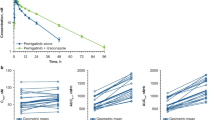Abstract
Prinomide tromethamine, a nonsteroidal antiinflammatory drug, was orally administered at doses of 250, 500, and 1000 mg every 12 hr for 28 days to healthy male volunteers. The pharmacokinetic behavior of prinomide and its primary plasma metabolite displayed nonlinear characteristics, while those of free prinomide and its metabolite were dose proportional. The nonlinear pharmacokinetic behavior of total prinomide and p-hydroxy metabolite was found to be caused by both saturable and mutually dependent competitive Langmuir-type plasma protein binding between prinomide and its p-hydroxy metabolite. The extent of the protein interaction displayed at steady state was due to the extensive accumulation of the p-hydroxy metabolite. While ligand–protein interactions are known for xenobiotic competitors, the characteristic behavior of prinomide is the first known example to be reported for a competitive protein interaction between a xenobiotic and its own in vivo generated metabolite. The findings of this study may have implications regarding the disposition of other extensively bound nonsteroidal antiinflammatory drugs with long-lived metabolites.
Similar content being viewed by others
REFERENCES
H. A. Bird, J. Hill, J. S. Dixon, R. Bosar, A. Traficante, M. A. Catalano, S. E. Adair, L. Liauw, H. Sussman, and H. Rotman. A clinical and biochemical assessment of prinomide in patients with rheumatoid-arthritis. J Rheumatol 16:448–454 (1989).
P. Davis and C. Johnston. Prinomide—Immunopharmacological profile of a new antirheumatic drug. Int. J. Imm. T. 6:61–70 (1990).
H. Egger, W. Itterly, V. John, R. Rodebaugh, C. Shimanskas, F. Stancato, and A. Kapoor. Disposition and metabolism of prinomide in laboratory animals. Drug Metab. Dispos. 16:568–575 (1988).
H. Egger, R. Iannucci, R. Luders, and L. Brunner. Disposition and metabolism of [14C]prinomide tromethamine in healthy subjects. In T. A. Baillie and J. R. Jones (eds.), Synthesis and Application of Isotopically Labelled Compounds 1988, Elsevier Science, New York, 1989, pp. 649–652.
R. C. Luders, L. Brunner, and L. B. Giedraitis. Simultaneous determination of CGS 10787B and its major metabolite (CGS 12094) in plasma by high performance liquid chromatrography. Anal. Lett. 19:2183–2196 (1986).
R. C. Luders and L. A. Brunner. Automated sample preparation and chromatographic analysis: Determination of CGS 10787B and related compounds. J. Chromatogr. Sci. 25:192–197 (1987).
J. J. MacKichan. Protein binding drug displacement interactions: Fact or fiction? Clin. Pharmacokin. 16:65–73 (1989).
R. K. Verbeeck, J. L. Blackburn, and G. R. Loewen. Clinical pharmacokinetics of non-steroidal anti-inflammatory drugs. Clin. Pharmacokin. 8:297–331 (1983).
D. C. Brater. Clinical pharmacology of NSAIDs. J. Clin. Pharmacokin. 28:518–523 (1988).
R. K. Verbeeck. Pharmacokinetic drug interactions with nonsteroidal anti-inflammatory drugs. Clin. Pharmacokin. 19:44–66 (1990).
Author information
Authors and Affiliations
Rights and permissions
About this article
Cite this article
Kochak, G.M., Pai, S., Iannucci, R. et al. Prinomide Tromethamine Pharmacokinetics: Mutually Dependent Saturable and Competitive Protein Binding Between Prinomide and Its Own Metabolite. Pharm Res 10, 49–55 (1993). https://doi.org/10.1023/A:1018916811904
Issue Date:
DOI: https://doi.org/10.1023/A:1018916811904




